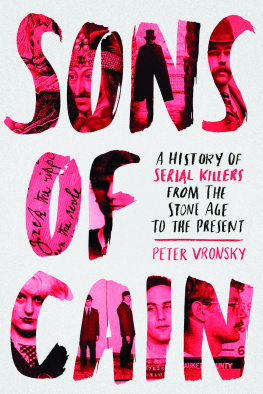Copyright and publication details
The Road to Murder: Why Driving is the Occupation of Choice for Britains Serial Killers
Adam G T Lynes
ISBN 978-1-909976-37-5 (Paperback)
ISBN 978-1-910979-22-8 (Epub ebook)
ISBN 978-1-910979-23-5 (Adobe ebook)
Copyright 2017 This work is the copyright of Adam G T Lynes. All intellectual property and associated rights are hereby asserted and reserved by him in full compliance with UK, European and international law. No part of this book may be copied, reproduced, stored in any retrieval system or transmitted in any form or by any means, or in any language, including in hard copy or via the internet, without the prior written permission of the publishers to whom all such rights have been assigned worldwide.
Cover design 2017 Waterside Press.
Main UK distributor Gardners Books, 1 Whittle Drive, Eastbourne, East Sussex, BN23 6QH. Tel: +44 (0)1323 521777; ; www.gardners.com
North American distribution Ingram Book Company, One Ingram Blvd, La Vergne, TN 37086, USA. Tel: (+1) 615 793 5000;
Cataloguing-In-Publication Data A catalogue record for this book can be obtained from the British Library.
Printed by Lightning Source.
e-book The Road to Murder is available as an ebook and also to subscribers of Myilibrary, Dawsonera, ebrary, and Ebscohost.
Published 2016 by
Waterside Press
Sherfield Gables
Sherfield-on-Loddon
Hook, Hampshire
United Kingdom RG27 0JG
Telephone +44(0)1256 882250
E-mail
Online catalogue WatersidePress.co.uk
Table of Contents
About the author
Adam Lynes is a Lecturer in Criminology at Birmingham City University and Deputy Head of the Homicide and Violent Crime (HaVoC) research cluster within the Centre for Applied Criminology. His research predominantly focuses on the significance of occupational choice for serial murderers leading to publications such as Serial Killers and the Phenomenon of Serial Murder (2016) (with David Wilson and Elizabeth Yardley), Waterside Press; Driving, Pseudo-Reality and the BTK: A Case Study (2015), Journal of Forensic Psychology and Offender Profiling (with David Wilson) and Zola and the Serial Killer: Robert Black and La Bte Humaine (2012), with others, International Journal of Criminology and Sociology . He has also written about other forms of violence in A Taxonomy of Male British Family Annihilators, 19802012 (2014), Elizabeth Yardley and others, Howard Journal .
The author of the Foreword
Professor David Wilson is one of the UKs leading criminologists, a National Teaching Fellow and presenter of a number of crime-related TV programmes. Based at Birmingham City University where he is Founding Director of the Centre for Applied Criminology, his books for Waterside Press include Serial Killers: Hunting Britons and Their Victims 19602006 (2007) and Mary Ann Cotton: Britains First Female Serial Killer (2013).
Acknowledgements
First and foremost I want to thank Professor David Wilson both for writing the Foreword to this work and his help with the manuscript generally.
My special thanks also go to Professor Michael Brookes and Professor Craig Jackson, in particular for the latters suggestions for implementing Hollands RIASEC model () which paved the way for what I believe to be some of the books most interesting findings.
Last but not least, I would like to thank my family for all their love, support, and encouragement, especially my parents who taught me the value of critical understanding and supported me in all my pursuits, and my grandmother, Brenda, whose love and support made this undertaking a reality.
Adam Lynes
April 2017
Foreword
From my own background working with serial killers and researching and writing about the phenomenon of serial murder, it soon became evident that much of the academic literature tended to be fixated on the mind of the killer. So, based on applied research undertaken in the United States in the 1970s and 1980s, there remains an extensive secondary literature on the biological and psychological makeup of serial killers, most of which attempted to uncover why these individuals repeatedly killed.
Whilst this research often referred to as the medical-psychological tradition has perhaps helped to improve what are often loosely described as profiling techniques, used when attempting to identify an unknown and still-at-large serial murderer, it was often based on dubious research methods and was largely accepted uncritically. In turn, this has helped to create some ongoing problems and fostered some enduring myths.
For example this particular approach is overly deterministic and tends to overlook other factors that exist outside of an individual serial killers psyche. Specific focus on how an individual serial killers biological or psychological makeup, for example, differs from other non-criminals has inevitably lead to an otherizing process. Whilst understandable after all, they have committed horrific crimes we tended to forget that many of the most notorious serial murderers that have existed went to school, had friends, got married and were employed. Indeed, Britains most prolific serial killer was a much respected GP. As such, at the most basic level, this suggested that we needed to think of new ways to theorise about serial killers and the phenomenon of serial murder.
In my own attempts to do so, for example, it became apparent that HOW individuals committed acts of serial murder was just as, if not more important than, WHY they killed. And, more generally, by taking a more sociological, or structural approach to serial murder, my own research showed that there are particular, marginalised groups in society that provide serial killers with a seemingly limitless pool of victims.
However, whilst these groups may indeed be vulnerable to attack by serial killers, and the contribution of the structural approach notwithstanding, the question remained as to whether the social and economic position of the killers themselves might also be a factor that was worthy of greater academic research.
In 2012 I tasked Adam Lynes, my PhD student at the time, to answer this question. In providing an answer into how the socio-economic position of serial killers influenced their offending behaviour, Adam drew attention to how their occupations, or lack thereof, appeared to be a significant factor in their success of committing multiple murder over a long period of time. In particular, his research, based on a multi-faceted case study, provided fresh theoretical insights into how specific occupational choice namely those that are transient in nature can significantly influence these offenders behaviour and HOW they committed their crimes. This is an important and not just a novel contribution.



















